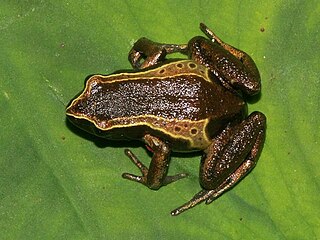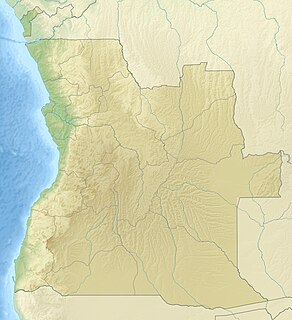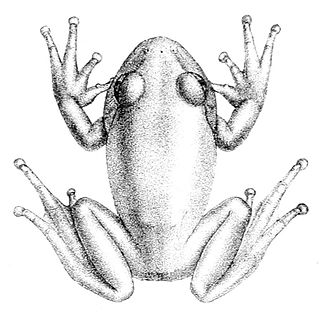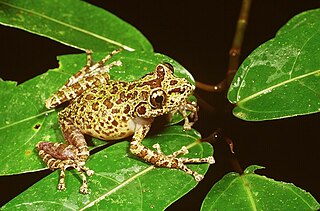
Arthroleptis is a genus of frogs in the family Arthroleptidae found in tropical sub-Saharan Africa. Their common names include screeching frogs, sometimes simply squeakers.

Cardioglossa is a genus of frogs in the family Arthroleptidae known as long-fingered frogs. They are native to western and central Africa, with the greatest species richness in Cameroon. They are found near streams in lowland and mountain forests, but also occur in other highland habitats near streams at up to 2,700 m (8,900 ft) in altitude. These are small frogs with a snout–to-vent length of 2 to 4 cm (0.8–1.6 in). Some of the more localized species are threatened.

Leptopelis is a genus of frogs in the family Arthroleptidae. They are found throughout Sub-Saharan Africa, excluding Madagascar. It is placed in monotypic subfamily Leptopelinae, although this subfamily is not always recognized. They have a number of common names, including forest treefrogs, tree frogs, leaf-frogs, and big-eyed frogs.
Arthroleptis carquejai is a species of frog in the family Arthroleptidae. It is known with certainty only from northwestern Angola, but there is also a recent record from Gabon. If this is correct, its distribution might also include intervening areas in the Republic of the Congo and the Democratic Republic of the Congo. The specific name carquejai honours Bento Carqueja, Portuguese professor, journalist, and philanthropist. Common names Cambondo screeching frog and Carqueja's squeaker have been proposed for it.
Cardioglossa alsco is a species of frog in the family Arthroleptidae. It is endemic to Cameroon and is known from its type locality on southern slopes of the Tschabal Mbabo Mountains as well as from the Gotel Mountains, both in the Adamawa Region. Its range might extend into Nigeria. The specific name alsco is a patronym for the American Linen Supply Company (ALSCO). The company's German branch supported the expedition during which this species was discovered.
Cardioglossa cyaneospila is a species of frog in the family Arthroleptidae. It is endemic to the Albertine Rift area in eastern Democratic Republic of the Congo, southwestern Uganda, Rwanda, and southwestern Burundi. It was described in 1950 by Raymond Laurent based on specimens collected in 1949. No new records were published until 2011. Recent research has uncovered both old unpublished records and several new records, and the conservation status was changed from "data deficient" to "near threatened" in 2016. Common names Bururi long-fingered frog and Mukuzira long-fingered frog have been coined for this species.

Cardioglossa leucomystax is a species of frog in the family Arthroleptidae. It is found in large parts of Central Africa, extending into south-easternmost West Africa (Nigeria). The type locality is Cap Saint Jean in Equatorial Guinea. Populations from the Upper Guinean Forests of West Africa between Ghana and Sierra Leone previously allocated to this species were in 2008 described as a new species, Cardioglossa occidentalis. Common name silver long-fingered frog has been coined for Cardioglossa leucomystax.
Cardioglossa melanogaster is a species of frog in the family Arthroleptidae. It is found in the mountains of western Cameroon and eastern Nigeria. Common name Amiet's long-fingered frog has been coined for it.
Cardioglossa nigromaculata is a species of frog in the family Arthroleptidae. It is found in the south-western Cameroon and in the extreme southern Nigeria at low altitudes. Common name blackspotted long-fingered frog has been coined for it.

Cardioglossa oreas is a species of frog in the family Arthroleptidae. It is endemic to Cameroon and known from the Western High Plateau between Mount Oku and the Bamboutos Mountains. Records from Mount Manengouba refer to Cardioglossa manengouba.
Cardioglossa pulchra is a species of frog in the family Arthroleptidae. It is found in the Cameroon Range in western Cameroon and in the Obudu Plateau in adjacent eastern Nigeria. Common name black long-fingered frog has been coined for it.
Cardioglossa schioetzi is a species of frogs in the family Arthroleptidae. It is found in the mountains of Cameroon and eastern Nigeria. Specifically, it has been recorded from the Oshie-Obudu Range, Gotel Mountains, Mount Oku, and Mount Mbam. It is a generally poorly known species.
Cardioglossa trifasciata is a species of frog in the family Arthroleptidae. It is endemic to western Cameroon and only known from the southern slopes of Mount Manengouba. Common name Nsoung long-fingered frog has been coined for it.
Cardioglossa venusta is a species of frog in the family Arthroleptidae. It is endemic to the mountains of western Cameroon. Specifically, it is known from Mount Manengouba, the Bamileke Highlands, Mount Nlonako, and the Rumpi Hills. Common name highland long-fingered frog has been coined for it.

Scotobleps is a monotypic frog genus in the family Arthroleptidae; its sole species is Scotobleps gabonicus, sometimes known as the Gaboon forest frog. It is found in eastern Nigeria, western Democratic Republic of the Congo, western and southwestern Cameroon, Equatorial Guinea, and western Gabon. It is also presumed to occur in the western Republic of the Congo and in the Cabinda Enclave of Angola.

Leptopelis calcaratus is a species of frog in the family Arthroleptidae. It is found in southeastern Nigeria, Cameroon, the southwestern Central African Republic, Equatorial Guinea, Gabon, the Republic of the Congo, and the Democratic Republic of the Congo. Common name Efulen forest treefrog has been coined for it.

Leptopelis marginatus is a species of frog in the family Arthroleptidae. It is endemic to western Angola and only known from the holotype collected from Quissange. The holotype was lost in the fire of the Natural History Museum of Lisbon in 1978. The validity of this species is in question; it might be a synonym of Leptopelis bocagii or considered a nomen dubium. Common name Quissange forest treefrog has been proposed for it.
The Tai forest tree frog, Leptopelis occidentalis, is a species of frog in the family Arthroleptidae. It is found in Liberia, southern Ivory Coast, and Ghana. Records from Nigeria are controversial and may refer to other species, possibly Leptopelis boulengeri.

Leptopelis viridis is a species of frog in the family Arthroleptidae. It is widely distributed in the West and Central African savanna zone between Senegal and the Gambia to the northeastern Democratic Republic of Congo.

Spinomantis peraccae is a species of frog in the mantellid subfamily Mantellinae. It is endemic to Madagascar and widely distributed in the northern, eastern, and central parts of the island. The specific epithet honours Italian herpetologist Mario Giacinto Peracca. Common name Peracca's Madagascar frog has been coined for it.









